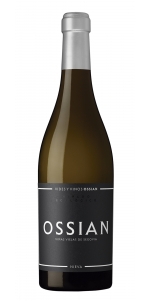Wine from Leon
A barrel fermented, old vines Verdejo made in a style different from what we typically see in this white varietal. It has a remarkable complexity, resulting in the smoothness and depth of a high-end white. Very suitable for cellaring.
Golden yellow color with greenish reflections. Complex, toasty aromas of nuts & dried fruit. Large, creamy, spicy, balanced and voluminous.
Rice with fish, cooked seafood, grilled seafood, baked white fish.
"The eponymous 2020 Ossian was produced with Verdejo grapes from old, organically farmed vines around the village of Nieva (Segovia), a zone where phylloxera didn't reach. They consider 2020 their finest vintage to date, with a big change from 2018 and when they have achieved a much better understanding of their vineyards. It has notes of pit fruit and sweet spices, with good weight on the palate, moderate alcohol (13.5%) and ripeness and good freshness and balance. It's serious and with potential to develop in bottle. 80,000 bottles produced. - Luis GUTIERREZ"
- Robert Parker's Wine Advocate (January 31st 2023), 94 pts
- back
Selected Options
Regions
Categories
Pricing
Countries
Regions
Grape Types
Wineries
Organic/Free Shipping
Mordoree Cotes du Rhone Dame Rousse Rose is made from 40% Grenache, 35% Syrah, 15% Cinsault, 5% Carignan, 5% Mourvèdre
Color : rosé, slightly orange (mordorée colour).
Aromas : crystallized oranges and cherries, slightly aniseed.
Palate : very rounded, fresh and long finish.
Ageing potential : 2 to 3 years
Surface : 14 Ha. Yield : 45 Hl./Ha. Vineyard age : 20 years Terroir : clay / chalk,clay / limestone and sandy with pebble stones. Harvest : by hand. Vinification : vat bleeding, temperature control. Estate bottled.
Food pairing: cold meats and delicatessen, fowl, white meats, grilled lamb with Provence herbs, fish soup, fried fish, pastas, pizzas and all Asian dishes.
Review:
"Based on 40% Grenache, 30% Syrah, 15% Cinsault, and the rest Carignan and Mourvèdre, awesome notes of framboise, wild strawberries, exotic spices, and a kiss of pressed flowers all emerge from the 2023 Côtes du Rhône Rosé, a beautifully balanced, medium-bodied rosé that has ample richness and depth. This stunning rosé is up with the best of them."
- Jeb Dunnuck (Importer Highlight: Fran Kysela ; July 2024), 92 pts
Mollydooker Velvet Glove Shiraz is made from 100 percent Shiraz.
Sticky plum jam and spicy nutmeg aromas are alluringly prominent on the nose, whilst berries and mocha weave
and envelop your entire palate. The finish is incredibly smooth and silky, with elegant fruit flavors that linger in your mouth. An outstanding example of a perfectly balanced Shiraz from McLaren Vale.
Review:
The stunning 2022 ‘The Velvet Glove’ is a stunning wine coming from the Gateway Vineyard in McLaren Vale. Stored in all new American oak barrels before bottling, this delivers a glassstaining purple, with blueberry pie and boysenberry cordial notes alongside tar, anise, Cuban cigar and suggestions of Black Forest cake on the nose. The absolutely gorgeous aromatics bring you back to the glass for more hedonistic pleasure. This is obviously big, bold and heady, but has remarkable freshness and seamless texture. This is very weightless stuff that will have a long life ahead of it. But why wait?
-Owen Bargreen 99 Points





